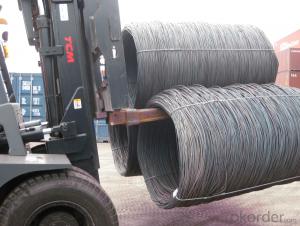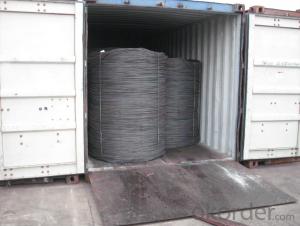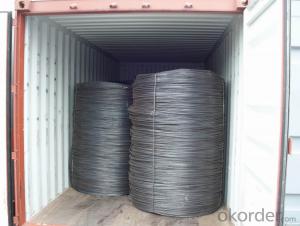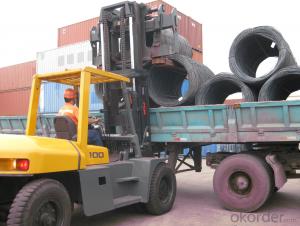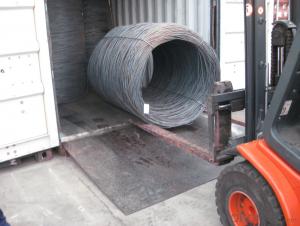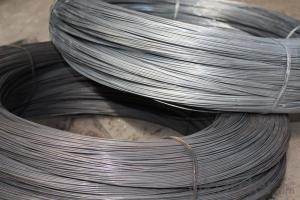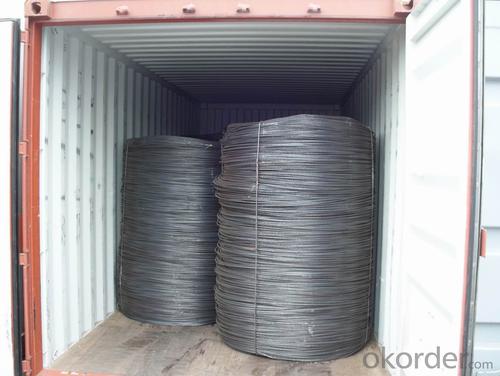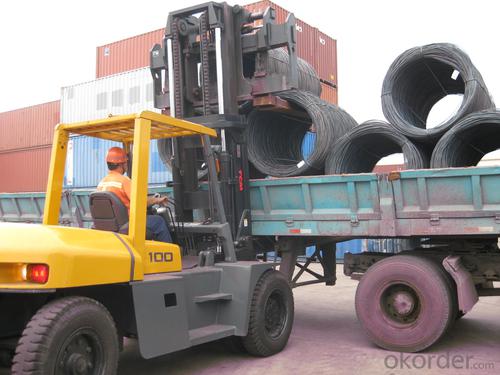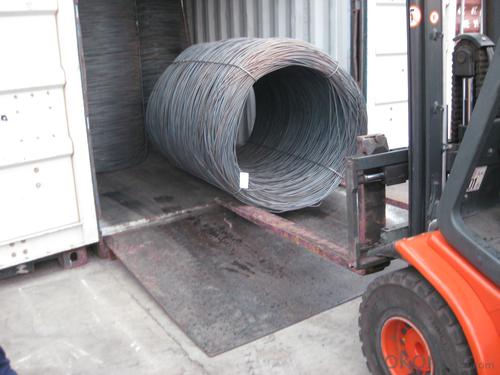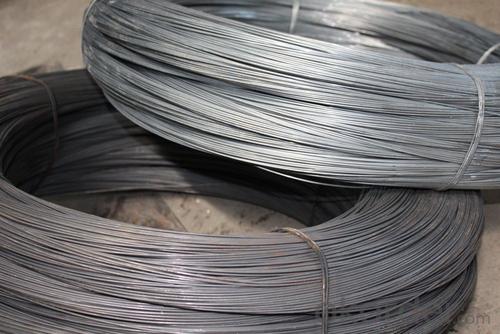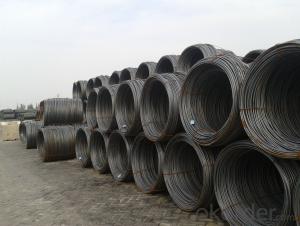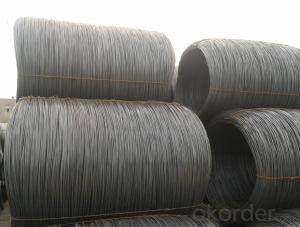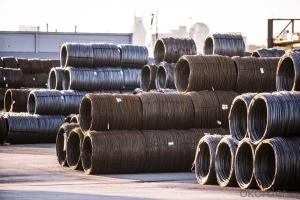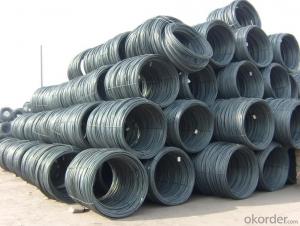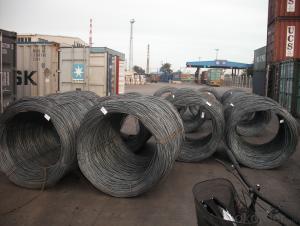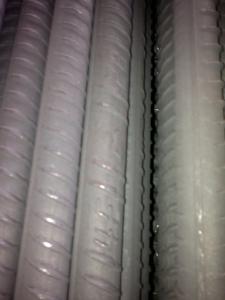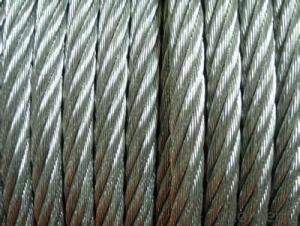SAE1006Cr Carbon Steel Wire Rod 10.5mm for Welding
- Loading Port:
- Shanghai
- Payment Terms:
- TT OR LC
- Min Order Qty:
- 100 m.t
- Supply Capability:
- 30000 m.t/month
OKorder Service Pledge
OKorder Financial Service
You Might Also Like
Specification
Description of SAE1006Cr Carbon Steel Wire Rod 10.5mm for Welding:
OKorder is offering Color Coated Steel Coil Prepainted Steel Coil at great prices with worldwide shipping. Our supplier is a world-class manufacturer of steel, with our products utilized the world over. OKorder annually supplies products to European, North American and Asian markets. We provide quotations within 24 hours of receiving an inquiry and guarantee competitive prices.
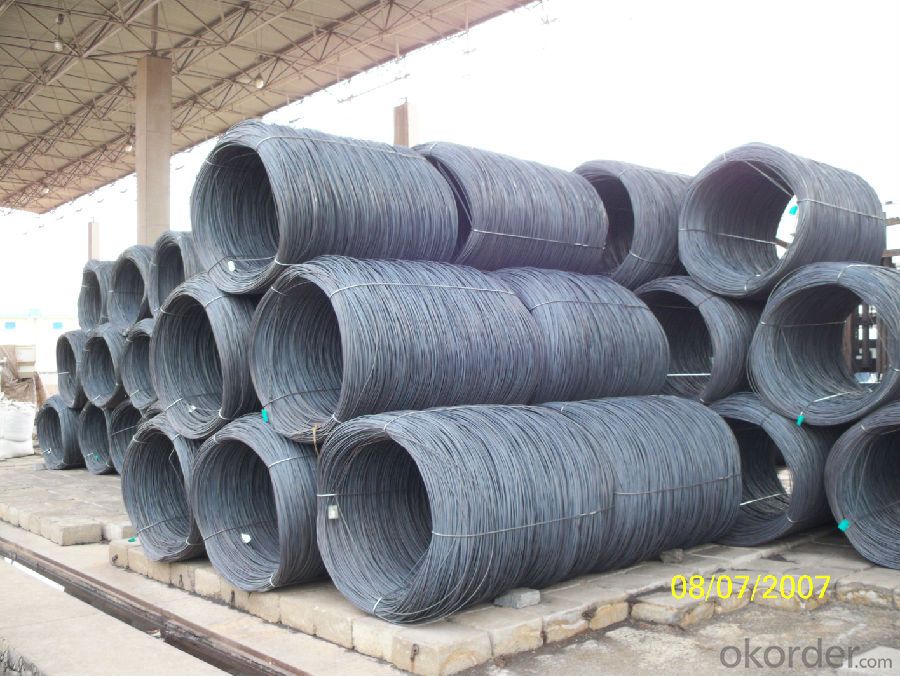
Applications of SAE1006Cr Carbon Steel Wire Rod 10.5mm for Welding:
Color Coated Steel Coil Prepainted Steel Coil are ideal for structural applications and are widely used in the construction of buildings and bridges, and the manufacturing, petrochemical, and transportation industries.
Main Product Features of SAE1006Cr Carbon Steel Wire Rod 10.5mm for Welding:
· Premium quality
· Prompt delivery & seaworthy packing (30 days after receiving deposit)
· Corrosion resistance
· Can be recycled and reused
· Mill test certification
· Professional Service
· Competitive pricing
Specifications of SAE1006Cr Carbon Steel Wire Rod 10.5mm for Welding:
PPGI:
1, Introduction: Color coated steel coils(sheets), i. E. PPGI, also called prepainted steel coils(sheets), are made of galvanized steel coils(sheets) with polymer coatings as surface. It's a new enclosure material and building board with characteristics of light-weighted, heat preserved&insulated, easily installed with bright colors.
2, Production Process: Pretreatment(Degreasing)_Drying_Chromating_Paint Basic Oil_Cooling_Drying_Color Coating_Cooling_Film-covering_Rolling Up
3, Characteristics:
Good at corrosion resistence. Besides zinc coating of the basic plate of galvanized steel sheet, the color coating as the surface has double lifetime to ensure better anticorrosion effect.
With excellent cold bending molded manufacturablity, PPGI products can be processed or directly used as final product. As being light-weighted and conveniently transported, they're widly used to replace wood to save energy.
4.There're thousands of colors can be chosen as per different application. Any color plays well in decoration.
No pollution with high recycling rate, PPGI coils and sheets are strongly recommended as enviroment-friendly products by the government.
5, eye bands and 4 circumferential bands in steel, galvanized metal fluted rings on inner and outer edges, galvanized.
| commodity | SAE1006Cr Carbon Steel Wire Rod 10.5mm for Welding |
| Techinical Standard: | JIS G3302-1998, EN10142/10137, ASTM A755 |
| grade | Q195,Q215,Q235,SAE1006,SAE1008 SAE1006Cr |
| Types: | Mesh welding |
| Base metal | galvanized, galvalume, cold rolled steel |
| Thickness | 0.14-1.0mm(0.16-0.8mm is the most advantage thickness) |
| Width | 610/724/820/914/1000/1200/1219/1220/1250mm |
| Type of coating: | PE, SMP, PVDF |
| Zinc coating | Z60-150g/m2 or AZ40-100g/m2 |
| Top painting: | 5 mic. Primer + 15 mc. R. M. P. |
| Back painting: | 5-7 mic. EP |
| Color: | According to RAL standard |
| ID coil | 508mm610mm |
| Coil weight: | 2--3MT |
| Package: | Properly packed for ocean freight exportation in 20'containers |
| Application: | Industrial panels, roofing and siding for painting/automobile |
| Price terms | FOB, CFR, CIF |
| Payment terms | 20%TT in advance+80% TT or irrevocable 80%L/C at sight |
| delivery time | 25 days after recepit of 20% TT |
| Remarks | Insurance is all risks |
| MTC 3.1 will be handed on with shipping documents | |
| We accept SGS certificatation test |
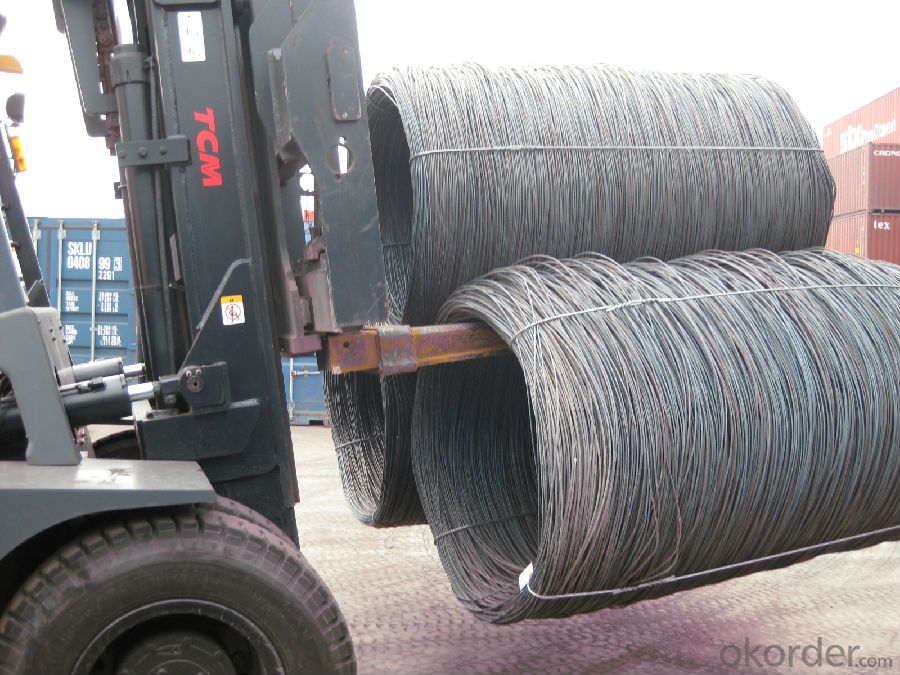
FAQ of SAE1006Cr Carbon Steel Wire Rod 10.5mm for Welding:
Q1: Why buy Materials & Equipment from OKorder.com?
A1: All products offered byOKorder.com are carefully selected from China's most reliable manufacturing enterprises. Through its ISO certifications, OKorder.com adheres to the highest standards and a commitment to supply chain safety and customer satisfaction.
Q2: How do we guarantee the quality of our products?
A2: We have established an advanced quality management system which conducts strict quality tests at every step, from raw materials to the final product. At the same time, we provide extensive follow-up service assurances as required.
Q3: How soon can we receive the product after purchase?
A3: Within three days of placing an order, we will begin production. The specific shipping date is dependent upon international and government factors, but is typically 7 to 10 workdays.
Q4: What makes stainless steel stainless?
A4: Stainless steel must contain at least 10.5 % chromium. It is this element that reacts with the oxygen in the air to form a complex chrome-oxide surface layer that is invisible but strong enough to prevent further oxygen from "staining" (rusting) the surface. Higher levels of chromium and the addition of other alloying elements such as nickel and molybdenum enhance this surface layer and improve the corrosion resistance of the stainless material.
Q5: Can stainless steel rust?
A5: Stainless does not "rust" as you think of regular steel rusting with a red oxide on the surface that flakes off. If you see red rust it is probably due to some iron particles that have contaminated the surface of the stainless steel and it is these iron particles that are rusting. Look at the source of the rusting and see if you can remove it from the surface.
- Q: How does the tensile strength of steel wire rod vary with different diameters?
- The tensile strength of steel wire rod can vary depending on its diameter. Generally, as the diameter of the wire rod increases, its tensile strength also tends to increase. This is because a larger diameter allows for more surface area, which helps the material resist deformation when under tension. In addition, a larger diameter wire rod usually contains more material, making the overall structure stronger. However, it is important to note that the relationship between diameter and tensile strength is not always straightforward. There comes a point where increasing the diameter of the wire rod may not have a significant impact on its tensile strength. This is because factors like the steel's grade, microstructure, and any treatments or heatings it undergoes can also affect its strength. Furthermore, factors other than diameter can influence the tensile strength of steel wire rod. These factors include the manufacturing process, as well as any subsequent treatments, such as drawing processes, heat treatments, and the presence of alloying elements. Therefore, when considering the tensile strength of steel wire rod with different diameters, it is crucial to consider all these factors in order to accurately determine the relationship between diameter and tensile strength.
- Q: What are the different types of defects that can occur in steel wire rod?
- There are several different types of defects that can occur in steel wire rods. These defects can arise during the manufacturing process or as a result of various external factors. Some common types of defects include surface defects, internal defects, and dimensional defects. Surface defects are often the most visible and can include scratches, pits, cracks, and scale. These defects can occur due to improper handling or storage of the wire rod, as well as issues during the rolling or finishing processes. Surface defects can affect the appearance and functionality of the wire rod and may require further processing or treatment to rectify. Internal defects are defects that occur within the structure of the wire rod and are not visible from the surface. These defects can include inclusions, voids, and segregations. Inclusions are foreign particles that have become trapped within the steel matrix during the manufacturing process. Voids are areas of missing material, while segregations refer to variations in the composition or structure of the steel. Internal defects can weaken the wire rod and reduce its mechanical properties, making it more prone to failure under stress or load. Dimensional defects refer to variations or deviations from the specified dimensions or tolerances of the wire rod. These defects can include variations in diameter, out-of-roundness, straightness, or surface finish. Dimensional defects can occur due to issues with the rolling process, improper cooling or heat treatment, or variations in the raw material used. These defects can affect the suitability and performance of the wire rod for its intended application. It is important to note that the occurrence of defects can be minimized through proper manufacturing practices, quality control measures, and adherence to industry standards and specifications. Regular inspection and testing of wire rods can help detect and address any defects, ensuring the production of high-quality and reliable steel wire rods.
- Q: How is steel wire rod classified based on its surface condition?
- Steel wire rod can be classified based on its surface condition into three main categories: 1) bright or untreated surface, 2) coated or galvanized surface, and 3) coated and drawn surface. 1) Bright or untreated surface: This refers to steel wire rod that has not undergone any surface treatment or coating. It has a clean and smooth surface, free from any contaminants or oxidation. Bright steel wire rod is commonly used in applications where a clean appearance or high conductivity is required, such as in the manufacturing of electrical wires, cables, and springs. 2) Coated or galvanized surface: Steel wire rod with a coated surface has been treated with a protective layer, typically through galvanization or coating with zinc, to enhance its corrosion resistance. This coating acts as a barrier against moisture and other corrosive elements, making the wire rod suitable for outdoor applications or environments with high humidity or exposure to chemicals. Coated steel wire rod is commonly used in construction, fencing, and automotive industries. 3) Coated and drawn surface: This refers to steel wire rod that has undergone both a coating and a drawing process. The coating is applied to the wire rod before it is drawn through a series of dies to reduce its diameter and increase its tensile strength. This process results in a smooth and uniform surface, with improved mechanical properties. Coated and drawn steel wire rod is commonly used in high-strength wire applications, such as wire ropes, tire reinforcement, and suspension springs. In summary, the classification of steel wire rod based on its surface condition helps to determine its suitability for different applications, taking into account factors such as corrosion resistance, conductivity, appearance, and mechanical properties.
- Q: How are steel wire rods used in the manufacturing of fishing nets?
- Steel wire rods are an essential component in the manufacturing of fishing nets. These rods serve as the skeletal structure of the net, providing strength and durability to withstand the harsh conditions of fishing. To begin the manufacturing process, the steel wire rods are first straightened and cut into various lengths, depending on the desired size of the net. These rods are then woven or knotted together to form the net's framework. The tight weaving ensures that the net is sturdy enough to withstand the pressure of catching fish and resist breaking or tearing. The steel wire rods used in fishing nets are specifically chosen for their high tensile strength and corrosion resistance. This makes them suitable for enduring the corrosive effects of saltwater, as fishing nets are primarily used in marine environments. Additionally, the steel wire rods are often coated with a protective layer, such as zinc or PVC, to further enhance their durability and prevent rusting. Furthermore, the flexibility of steel wire rods allows the fishing net to adapt to different shapes and sizes. This flexibility is crucial as it enables the net to conform to the contours of the water, maximizing its effectiveness in capturing fish. In conclusion, steel wire rods play a vital role in the manufacturing of fishing nets, providing the necessary strength, durability, and flexibility. Their high tensile strength and corrosion resistance make them an ideal choice for withstanding the harsh conditions of fishing. Without these steel wire rods, the manufacturing of fishing nets would not be possible, and the fishing industry would be greatly impacted.
- Q: What are the different international specifications for steel wire rod?
- There are several different international specifications for steel wire rod, which outline the specific requirements and characteristics that the wire rod must meet. Some of the most commonly used international specifications for steel wire rod include: 1. ASTM A510: This specification covers general requirements for carbon steel wire rods and applies to both hot-rolled and cold-finished wire rods. 2. EN 10016-2: This European standard specifies the general requirements for non-alloy steel rod and wire for cold heading and cold extrusion. 3. JIS G 3505: This Japanese Industrial Standard covers low carbon steel wire rods for general use, including welding wire, nails, and wire ropes. 4. GB/T 699: This Chinese national standard defines the technical requirements for carbon structural steels, including wire rods. 5. ISO 16120-4: This international standard specifies the general requirements for steel wire rod, including dimensional tolerances, mechanical properties, and testing methods. Additionally, various industry-specific standards and specifications may exist for steel wire rod used in specific applications, such as automotive, construction, or electrical industries. These may include standards from organizations like SAE International or specific customer requirements. It is essential to consult the relevant specifications when manufacturing or sourcing steel wire rod to ensure compliance with the required standards and meet the specific needs of the intended application.
- Q: What are the advantages of using steel wire rods in construction?
- Using steel wire rods in construction offers several benefits. Firstly, their exceptional strength and durability make them ideal for structural applications. They possess a high tensile strength, enabling them to withstand heavy loads and resist deformation. Consequently, frequent repairs or replacements are reduced, ensuring long-lasting constructions. Secondly, steel wire rods are incredibly flexible, enabling easy shaping and bending to fit diverse construction designs and requirements. This flexibility allows architects and engineers to create intricate and innovative structures while ensuring structural integrity. Moreover, steel wire rods exhibit excellent resistance to corrosion. They are frequently galvanized or coated with protective layers, preventing rust and corrosion. This enhances their lifespan and reliability, particularly in harsh environmental conditions. Additionally, they are suitable for use in coastal or high-humidity areas where other materials may deteriorate over time. Furthermore, steel wire rods are cost-effective. They are readily available, making them a cost-efficient alternative to other construction materials. Their versatility and ease of installation also contribute to reducing labor and construction costs. Another advantage of steel wire rods is their eco-friendliness. Steel is a highly recyclable material, and incorporating steel wire rods in construction helps conserve natural resources and minimize waste. Furthermore, steel structures can be disassembled and reused, reducing the environmental impact associated with construction activities. Lastly, steel wire rods offer an added layer of safety as they are fire-resistant. Steel does not burn or contribute to the spread of fire, which is crucial in preventing loss of life and property during fire incidents. In conclusion, the advantages of using steel wire rods in construction lie in their strength, flexibility, corrosion resistance, cost-effectiveness, sustainability, and fire resistance. These qualities make them the preferred choice for various construction applications, contributing to the overall quality and longevity of structures.
- Q: How is the ductility of steel wire rod measured?
- The ductility of steel wire rod is typically measured using a test called the tensile test, also known as the tension test. In this test, a sample of the steel wire rod is subjected to gradually increasing tensile forces until it fractures. Throughout the test, the elongation or deformation of the sample is measured, which provides an indication of its ductility. During the tensile test, the steel wire rod sample is clamped at both ends and a gradually increasing force is applied to one end. As the force is applied, the sample begins to elongate, and the amount of elongation is recorded. This elongation is usually measured as a percentage of the original length of the sample and is called the percentage elongation. In addition to measuring the elongation, the tensile test also measures the ultimate tensile strength of the steel wire rod. This is the maximum stress that the sample can withstand before it fractures. The ultimate tensile strength is an important parameter in assessing the overall mechanical properties of the steel wire rod. By conducting tensile tests on multiple samples of the steel wire rod, the average ductility of the material can be determined. This information is crucial in various industries that utilize steel wire rod, such as construction, automotive, and manufacturing, as it helps engineers and designers understand how the material will behave under different loads and conditions.
- Q: What is the difference between hot rolled and cold drawn steel wire rod?
- Hot rolled steel wire rod is produced by passing a heated billet through a series of rolling mills, resulting in a larger diameter and a rougher surface finish. On the other hand, cold drawn steel wire rod is formed by pulling a hot rolled wire rod through a die at room temperature, resulting in a smaller diameter and a smoother surface finish.
- Q: What are the main regions for steel wire rod production?
- The main regions for steel wire rod production include Asia, particularly China, Japan, and South Korea, North America, specifically the United States, and Europe, with countries like Germany, Italy, and France being major producers.
- Q: What is the average lifespan of steel wire rod?
- The average lifespan of steel wire rod can vary depending on various factors such as the quality of the steel, the environment it is exposed to, and the level of maintenance it receives. Generally, steel wire rod is designed to be durable and long-lasting. With proper care and maintenance, it can last for many years. However, if the steel wire rod is exposed to harsh conditions such as extreme temperatures, corrosive substances, or excessive stress, its lifespan may be shortened. It is also important to note that the average lifespan of steel wire rod can vary depending on its specific application. For example, steel wire rod used in construction may have a different lifespan compared to steel wire rod used in electrical wiring. Therefore, it is advisable to consult the manufacturer or industry standards for a more accurate estimate of the average lifespan of steel wire rod in a specific application.
Send your message to us
SAE1006Cr Carbon Steel Wire Rod 10.5mm for Welding
- Loading Port:
- Shanghai
- Payment Terms:
- TT OR LC
- Min Order Qty:
- 100 m.t
- Supply Capability:
- 30000 m.t/month
OKorder Service Pledge
OKorder Financial Service
Similar products
Hot products
Hot Searches
Related keywords
